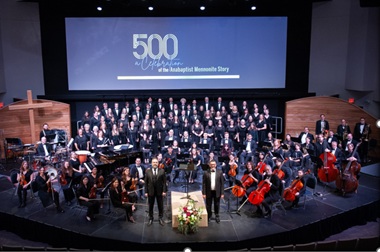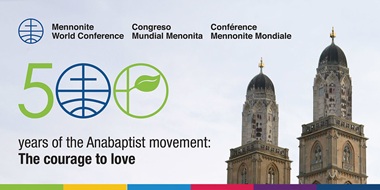
Celebrating the 500th anniversary of Anabaptism at Central Heights Church in Abbotsford. Photo: Dianna Lewis
On the afternoon of March 1, the birth of Anabaptism was jubilantly celebrated at the Central Heights Church in Abbotsford, where perhaps 5 – 10 percent of the local population attend Mennonite congregations. Mennonites make up a significant portion of the Anabaptist world.
Directed by Calvin Dyck and Ben Ewert, a 70-voice choir and a 42-piece band performed much loved hymns from a diverse Mennonite musical legacy, including the Mennonite Piano Concerto composed by Victor Davies.
Similar celebrations across North America and Europe will culminate May 29, 2025 in Zurich, Switzerland.
The question contemporary believers need to ask is this: exactly what is being celebrated with so much fanfare?
Collective memory of pain
The 16th century Reformation was a birth-mother to vibrant new life. Among its offspring was Anabaptism, a spiritual communion which in the opinion of scholar Leonard Verduin, was a step-child. By any assessment, Anabaptism was a hybrid faith, neither Catholic nor Protestant. Its birth was fragile and painful, without a mid-wife to assist in the delivery.
Our story owes its beginnings to several believers with big hearts and a lot of courage, who on January 21, 1526 were baptized, this time as adults. The occasion is indelibly captured in the Hutterite Chronicles.

George Blaurock (pictured) beseeched Conrad Grebel to baptize him. (painting by Oliver Wendell Schenk, Laurelville Mennonite Church Center)
One source stated:
A group of believers were together until fear came upon them. Thereupon they bowed their knees to the Most High God. They called upon him as the Informer of Hearts, pleading for divine leading.
After thus praying, and knowing they would have to suffer for their decision, George Blaurock stood up and beseeched Conrad Grebel: “For God’s sake, baptize me with the correct baptism.”
After being baptized, Blaurock baptized all those present. Together they pledged themselves to be true disciples of Christ, and to live lives separated from the world.
Anabaptism was born. A magisterial Roman Church was outraged and a faltering Holy Roman Empire shaken.
“It was the insistence of believer’s baptism that precipitated the crisis.” The blowback was not long in coming. Like first-generation believers in Christ, first-generation Anabaptists sealed the price of their convictions with their blood.
Lest we forget. The first recorded Anabaptist martyr was Eberli Bolt, who was burned at the stake on May 29, 1525, in Schwyz, Switzerland. Although the exact number of martyrs will never be known, gruesome killings continued for three centuries, by some estimates, harvesting 2,500 souls.
After being captured, Anabaptist leader Felix Manz was taken to the Limmat River, his legs bound as he sang out in a loud voice, “Into thy hands oh Lord, I commend my spirit.” From the river shore, witnesses heard his mother’s voice entreating her son to remain strong. According to a Zurich chronicler, Manz was drowned on a Saturday afternoon on January 5, 1527.
A similar fate befell Blaurock, who “impressed no one with his learning but everyone with his zeal.” Wherever he travelled, believers were baptised and congregations formed. Although his life was cut short, his witness to Jesus survives. On September 6, 1529 he was sentenced to death, on charges of abandoning the Catholic priesthood and practicing adult baptism. Enroute to his execution, he earnestly cited scripture to those lining his martyr route.
A rope with many cords shall not easily be torn asunder. A third early Anabaptist leader who died a martyr was Michael Sattler. He was one of the preachers at an Anabaptist conference out of which emerged the Schleitheim Confession, an eloquent expression of early Anabaptist beliefs.
He was sentenced to death on May 20, 1527, by drowning in the Neckar River. His sentence demanded that he be horribly tortured before his body was burned, and he was declared “an arch-heretic.” A contemporary Lutheran pastor testified to Sattler’s character: “He was not highly educated . . . but his entire life was noble, pure and unadulterated.”
State and church officials were confounded. The more Anabaptists they killed, the greater was the spread of their faith, causing one writer to note that against the darkness of Europe’s long night of death: “The Anabaptists they killed, but the truth they could not quench.”
An enduring spirituality

Anabaptists will gather in Zurich May 29 .
With such fragile beginnings, how is it that the Anabaptist faith continues to pulsate with life, when during the past 500 years untold numbers of spiritual communions have expired? Globally today, there are some 1.47 million baptized Anabaptist believers, worshiping in more than 10,000 churches, some of them with no Mennonite affiliation.
Although the faith implications for contemporary believers are numerous, I will refer only to several of them.
Central to these 16th century forbears was a conviction that Jesus lives at the core of our being. Jesus as teacher was for Anabaptists the lens through which all of Scripture was understood, and particularly as expressed in the Beatitudes and the Parables. And, often controversially, their contention that embracing Jesus without embracing life as peace-makers was incompatible.
What Anabaptist forbears accomplished at a great cost must not be taken for granted – that entry to church membership happens only through the rite of adult baptism: “Where baptism in water does not exist, there is no church.”
And related to that, anyone wishing entry into church fellowship, must do so entirely out of their own free will. “Every religious [confession] that gets tied up with coercion, must of necessity become corrupt.” It is these non-negotiables that were bequeathed to millions of contemporary believers the Free Church tradition.
Anabaptists rejected out of hand a domesticated and tamed Jesus as well as a distorted faith that permitted a local church to be overshadowed by state-controlled decision makers. Fundamental was the Anabaptist insistence on strict segregation between church and state.
One early Anabaptist leader taught forcefully, “To allow external authority to rule in the Kingdom of Christ brings blasphemy to the Holy Spirit.”
Not so simple in our time, as Mennonite believers increasingly serve in high political office, as well as in judicial and police occupations. Self-evidently, freedom of choice can be a two-edged sword.
Not long ago local media informed us that some 50 pastors and elders from 19 churches in the Fraser Valley rejected BC government worship meeting protocols. How then do believers decide what constitutes unacceptable government interference in personal and congregational matters, or when government directives serve community wellbeing?
And equally challenging – how can divisive political ideologies among believers be prevented from corrupting wholesome spiritual unity.
At the core of Anabaptism is a determined emphasis on helping those in peril. Memorably, prominent Anabaptist Hans Denck set this bench mark: “No one can know Christ unless he follow him in life.”
This faith heritage insists that human need requires a human response, as Menno Simons put it. “True evangelical faith . . . cannot lie dormant . . . It clothes the naked. It feeds the hungry.”
Anabaptism – a big deal? If measured by the profound prayer of our Lord (John 17), “that they be one,” Anabaptists are a work in progress, with more than 60 divisions globally. That said, this living heritage continues to inspire humble gratitude. There is an ongoing obligation to celebrate and share what has been passed down at great cost: “Remember your [Anabaptist] leaders, who spoke the word of God to you.”
Conclusions
At least occasionally I think we would do well to learn from one of the ancients who insisted on riding his mule backwards so that he would not be distracted by where he was going and instead reflect on where he had come from.
As our Anabaptist forbears knew from vivid personal experience, so we also live in fast-changing, tumultuous times, where believers are a small minority. In this milieu, longevity is not a given without the ongoing work of God’s Spirit within us. “Nothing wilts faster than the laurels we rest on.”
Main Sources
- Estep, William: The Anabaptist Story, (Eerdmans, 1963)
- Klaassen, Walter, editor: Anabaptism in Outline: Selected Primary Sources, (Herald Press, 1981)
- Murray, Stuart: The Naked Anabaptist, (Herald Press, 2010)
- Verduin, Leonard: The Reformers and Their Stepchildren, (Eerdmans, 1964)
David Giesbrecht grew up in the Mennonite community, born in Manitoba, raised in the Fraser Valley. He lives in Abbotsford, where he is involved in Clearbrook Mennonite Brethren Church. He has a Masters degree in Library Science and was Library Director for almost two decades at Columbia Bible College. He has participated in a variety of community boards over the years and has teaching and library experiences in Nigeria, Jamaica and the Czech Republic. He continues to be editorially involved with the online encyclopedia, GAMEO (Global Anabaptist Mennonite Encyclopedia Online).
